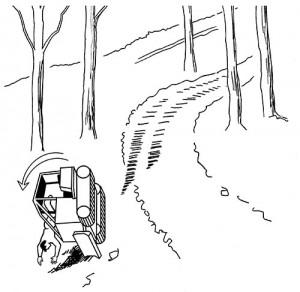BACKGROUND: A bulldozer operator was working alone clearing a logging road on an early Spring morning in the Appalachians. The ground was still frozen.
PERSONAL CHARACTERISTICS: The 23-year-old bulldozer operator was co-owner of the construction company that had contracted for the job of clearing a logging road. His previous record of safety training, work experience, and safety is unknown.
UNSAFE ACT AND CONDITIONS: The 1970-model bulldozer was equipped with a rollover protective structure (ROPS), but it was not equipped with a seatbelt, safety harness, or doors. The operator was working alone on a small hillside in frozen ground conditions, which reduced the stability and the traction of the bulldozer.
ACCIDENT: Although the accident was unwitnessed, the bulldozer was discovered in an overturned position when the property owner saw that the operator’s truck was still at the work site in the evening, but no equipment could be heard running. The landowner went to the site and discovered the operator trapped beneath the bulldozer. Investigation later attributed the accident to the machine flipping sideways on a small hill, due at least partially to the ground’s frozen condition.
INJURY: The first responders who arrived at the scene believe that the operator died almost instantaneously, having been thrown from the equipment and then trapped beneath it. His death was attributed to blunt force trauma.
RECOMMENDATIONS FOR CORRECTION:
• Operators of heavy equipment should wear a seatbelt to keep them within the protective zone of the ROPS in the event of a rollover.
• Operators should use extra caution when using heavy equipment on steep terrain—keeping the tracks positioned straight up and down the slope—and should not operate bulldozers where hazards such as frozen ground, stone outcroppings, or loose rock would cause the dozer to lose stability on hilly terrain.
• If available, a tracked excavator may be a better alternative to a dozer in some situations, because it can often reach ahead from a stable position and cut the slope/road.
• Recognize the safety hazards of operating very old equipment that does not have completely enclosed cabs and is not “purpose-built” to reduce exposure to in-woods hazards such as steep terrain, woody brush/spears, etc. (Do not remove seatbelts and doors installed on machines, and ensure they are maintained in working order.)
 Courtesy of the Forest Resources Association: https://www.forestresources.org/page.asp?content=startpage&g=FRA
Courtesy of the Forest Resources Association: https://www.forestresources.org/page.asp?content=startpage&g=FRA
